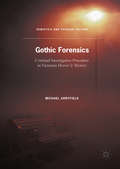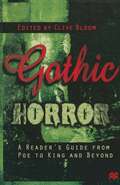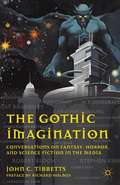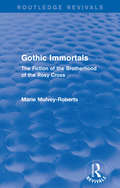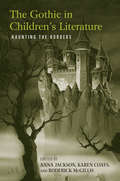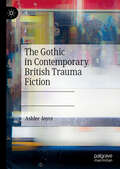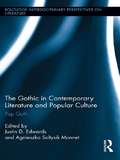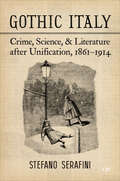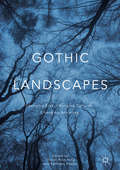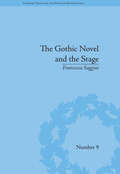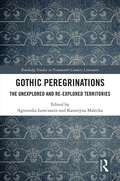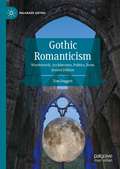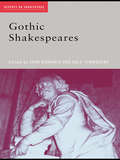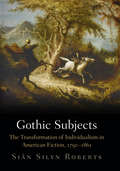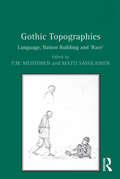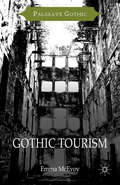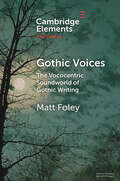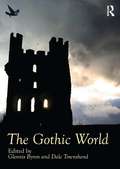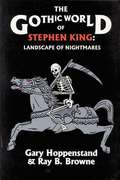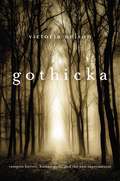- Table View
- List View
Gothic Forensics
by Michael ArntfieldMichael Arntfield interrogates the legacy of Victorian-era crime fiction and Gothic horror on investigative forensic methods used by police today.
Gothic Horror: A Guide for Students and Readers
by Clive BloomThis highly accessible anthology of Gothic writings and criticism provides an essential guide to the genre. The second edition of this critically acclaimed book has been thoroughly revised to include material from the early gothic and a fresh set of contemporary essays, with a supporting timeline and thought provoking introductory material.
The Gothic Imagination
by John C. TibbettsThis book brings together the author's interviews with many prominent figures in fantasy, horror, and science fiction to examine the traditions and extensions of the gothic mode of storytelling over the last 200 years and its contemporary influence on film and media.
Gothic Immortals (Routledge Revivals): The Fiction of the Brotherhood of the Rosy Cross
by Marie Mulvey-RobertsFirst published in 1990, this book represents the first full-length study of into the group of novels designated ‘Rosicrucian’ and traces the emergence of this distinct fictional genre, revealing a continuous occult tradition running through seemingly diverse literary texts. Taking the Enlightenment as a starting point, the author shows how the physician’s secular appropriation of the idea of eternal life, through the study of longevity and physical decay, attracted writers like William Godwin. It focuses on the bodily immortality of the Rosicrucian hero and investigates the novels of five major writers — Godwin, Percy Bysshe Shelley, Mary Shelley, Maturin, and Bulwer-Lytton.
The Gothic in Children's Literature: Haunting the Borders (Children's Literature and Culture #43)
by Karen Coats Anna Jackson Roderick McGillisFrom creepy picture books to Harry Potter, Lemony Snicket, the Spiderwick Chronicles, and countless vampire series for young adult readers, fear has become a dominant mode of entertainment for young readers. The last two decades have seen an enormous growth in the critical study of two very different genres, the Gothic and children’s literature. The Gothic, concerned with the perverse and the forbidden, with adult sexuality and religious or metaphysical doubts and heresies, seems to represent everything that children’s literature, as a genre, was designed to keep out. Indeed, this does seem to be very much the way that children’s literature was marketed in the late eighteenth century, at exactly the same time that the Gothic was really taking off, written by the same women novelists who were responsible for the promotion of a safe and segregated children’s literature. This collection examines the early intersection of the Gothic and children’s literature and the contemporary manifestations of the gothic impulse, revealing that Gothic elements can, in fact, be traced in children’s literature for as long as children have been reading.
The Gothic in Contemporary British Trauma Fiction
by Ashlee JoyceThis book examines the intersection of trauma and the Gothic in six contemporary British novels: Martin Amis’s London Fields, Margaret Drabble’s The Gates of Ivory, Ian McEwan’s Atonement, Pat Barker’s Regeneration and Double Vision, and Kazuo Ishiguro’s Never Let Me Go. In these works, the Gothic functions both as an expression of societal violence at the turn of the twenty-first century and as a response to the related crisis of representation brought about by the contemporary individual’s highly mediated and spectatorial relationship to this violence. By locating these six novels within the Gothic tradition, this work argues that each text, to borrow a term from Jacques Derrida, “participates” in the Gothic in ways that both uphold the paradigm of “unspeakability” that has come to dominate much trauma fiction, as well as push its boundaries to complicate how we think of the ethical relationship between witnessing and writing trauma.
The Gothic in Contemporary Literature and Popular Culture: Pop Goth (Routledge Interdisciplinary Perspectives on Literature)
by Justin D. Edwards Agnieszka Soltysik MonnetThis interdisciplinary collection brings together world leaders in Gothic Studies, offering dynamic new readings on popular Gothic cultural productions from the last decade. Topics covered include, but are not limited to: contemporary High Street Goth/ic fashion, Gothic performance and art festivals, Gothic popular fiction from Twilight to Shadow of the Wind, Goth/ic popular music, Goth/ic on TV and film, new trends like Steampunk, well-known icons Batman and Lady Gaga, and theorizations of popular Gothic monsters (from zombies and vampires to werewolves and ghosts) in an age of terror/ism.
Gothic Italy: Crime, Science, and Literature after Unification, 1861–1914 (Toronto Italian Studies)
by Stefano SerafiniThe Gothic, proliferating across different literary, socio-cultural, and scientific spaces, permeated and influenced the project of Italian nation-building, casting a dark and pervasive shadow on Italian history. Gothic Italy explores the nuances, contradictions, and implications of the conflict between what the Gothic embodies in post-unification Italy and the values that a supposedly secular, modern country tries to uphold and promote. The book analyses a variety of literary works concerned with crime that tapped into fears relating to contagion, race, and class fluidity; deviant minds and abnormal sexuality; female transgression; male performativity; and the instability of the new body politic. By tracing how writers, scientists, and thinkers engaged with these issues, Gothic Italy unveils the mutual network of exchanges that informed national discourses about crime. Stefano Serafini brings attention to a historical moment that was crucial to the development of modern attitudes towards normality and deviance, which continue to circulate widely and still resonate disturbingly in contemporary society.
Gothic Landscapes
by Sharon Rose Yang Kathleen HealeyThis book is about the ways that Gothic literature has been transformed since the 18th century across cultures and across genres. In a series of essays written by scholars in the field, the book focuses on landscape in the Gothic and the ways landscape both reflects and reveals the dark elements of culture and humanity. It goes beyond traditional approaches to the Gothic by pushing the limits of the definition of the genre. From landscape painting to movies and video games, from memoir to fiction, and from works of different cultural origins and perspectives, this volume traverses the geography of the Gothic revealing the anxieties that still haunt humanity into the twenty-first century.
Gothic Nostalgia: The Uses of Toxic Memory in 21st Century Popular Culture (Palgrave Gothic)
by Simon Bacon Katarzyna Bronk-BaconThis book is an original and innovative study of how Gothic nostalgia and toxic memory are used to underpin and promote the ongoing culture wars and populist politics in contemporary popular culture. The essays collected here cover topics from the spectral to the ecological, deep fakes to toxic ableism, Mary Poppins to John Wick to reveal how the use of an imaginary past to shape the present, creates truly Gothic times that we can never escape. These ‘hungry ghosts’ from the past find resonance with the Gothic which speaks equally of a past that often not only haunts the present but will not let it escape its grasp. This collection will look at the confluence between various kinds of toxic nostalgia and popular culture to suggest the ways in which contemporary populism has resurrected ideological monsters from the grave to gorge on the present and any possibility of change that the future might represent.
The Gothic Novel and the Stage: Romantic Appropriations (Literary Texts and the Popular Marketplace #9)
by Francesca SagginiIn this ground-breaking study Saggini explores the relationship between the late eighteenth-century novel and the theatre, arguing that the implicit theatricality of the Gothic novel made it an obvious source from which dramatists could take ideas. Similarly, elements of the theatre provided inspiration to novelists.
Gothic Peregrinations: The Unexplored and Re-explored Territories (Routledge Studies in Nineteenth Century Literature)
by Agnieszka Lowczanin Katarzyna MaleckaFor over two hundred years, the Gothic has remained fixed in the European and American imaginations, steadily securing its position as a global cultural mode in recent decades. The globalization of Gothic studies has resulted in the proliferation of new critical concepts and a growing academic interest in the genre. Yet, despite its longevity, unprecedented expansion, and accusations of prescriptiveness, the Gothic remains elusive and without a straightforward definition. Gothic Peregrinations: The Unexplored and Re-explored Territories looks at Gothic productions largely marginalized in the studies of the genre, including the European absorption of and response to the Gothic. This collection of essays identifies landmarks and ley lines in the insufficiently probed territories of Gothic scholarship and sets out to explore its unmapped regions. This volume not only examines Gothic peregrinations from a geographical perspective but also investigates how the genre has been at odds with strict demarcation of generic boundaries. Analyzing texts which come from outside the Gothic canon, yet prove to be deeply indebted to it, like bereavement memoirs, stories produced by and about factory girls of Massachusetts, and the Mattel Monster High franchise, this volume illuminates the previously unexplored fields in Gothic studies. The chapters in this volume reveal the truly transnational expansion of the Gothic and the importance of exchange – exchange now seen not only as crucial to the genre’s gestation, or vital to the processes of globalization, but also to legitimizing Gothic studies in the global world.
Gothic Romanticism: Wordsworth, Architecture, Politics, Form (Palgrave Gothic)
by Tom DuggettGothic Romanticism: Wordsworth, Architecture, Politics, Form offers a revisionist account of both Wordsworth and the politics of antiquarianism in the late eighteenth and early nineteenth centuries. As a historically-driven study that develops a significant critique and revision of genre- and theory-based approaches to the Gothic, it covers many key works by Wordsworth and his fellow “Lake Poets” Samuel Taylor Coleridge and Robert Southey. The second edition incorporates new materials that develop the argument in new directions opened up by changes in the field over the last decade. The book also provides a sustained reflection upon Romantic conservatism, including the political thought and lasting influence of Edmund Burke. New material places the book in wider and longer context of the political and historical forms seen developing in Wordsworth, and proposes Gothic Romanticism as the alternative line of cultural development to Victorian Medievalism.
Gothic Science Fiction
by Sian MacarthurGothic Science Fiction is a comprehensive account of the rise of a fascinating genre that has grown out of the Gothic. From the dark and mysterious world of mad scientists to the horrors and terrors associated with monsters and aliens, Sian MacArthur takes the reader through a madcap journey to identify those features of the Gothic that have influenced and continue to influence the world of science fiction. From Frankenstein to Doctor Who and from H. G Wells to Stephen King, the book explores several aspects, beginning with Mary Shelley and bringing the subject matter right up to date with the inclusion of works by Justin Cronin and Daniel Wilson. Gothic Science Fiction gives the crazy and always interesting world of Gothic science fiction detailed attention in an account that is both accessible and engaging.
Gothic Shakespeares (Accents on Shakespeare #10)
by John Drakakis Dale TownshendReadings of Shakespeare were both influenced by and influential in the rise of Gothic forms in literature and culture from the late eighteenth century onwards. Shakespeare’s plays are full of ghosts, suspense, fear-inducing moments and cultural anxieties which many writers in the Gothic mode have since emulated, adapted and appropriated. The contributors to this volume consider: Shakespeare’s relationship with popular Gothic fiction of the eighteenth century how, without Shakespeare as a point of reference, the Gothic mode in fiction and drama may not have developed and evolved in quite the way it did the ways in which the Gothic engages in a complex dialogue with Shakespeare, often through the use of quotation, citation and analogy the extent to which the relationship between Shakespeare and the Gothic requires a radical reappraisal in the light of contemporary literary theory, as well as the popular extensions of the Gothic into many modern modes of representation. In Gothic Shakespeares, Shakespeare is considered alongside major Gothic texts and writers – from Horace Walpole, Ann Radcliffe, Matthew Lewis and Mary Shelley, up to and including contemporary Gothic fiction and horror film. This volume offers a highly original and truly provocative account of Gothic reformulations of Shakespeare, and Shakespeare’s significance to the Gothic. Contributors include: Fred Botting, Elizabeth Bronfen, Glennis Byron, Sue Chaplin, Steven Craig, John Drakakis, Michael Gamer, Jerrold Hogle, Peter Hutchings, Robert Miles, Dale Townshend, Scott Wilson and Angela Wright.
Gothic Subjects: The Transformation of Individualism in American Fiction, 1790-1861
by Siân Silyn RobertsBeginning in the 1790s, North American readers developed an appetite for the gothic novel, as imported, reprinted, and pirated editions of British and European romances flooded the market alongside homegrown works. In Gothic Subjects, Siân Silyn Roberts accounts for the sudden and considerable appeal of the gothic during this period by contending that it prepared a culturally diverse American readership to think of itself as part of a transatlantic world through which goods, people, and information could circulate. By putting gothic literature in dialogue with the writings of Locke, Hume, Reid, Smith, Rousseau, and other major figures of the European Enlightenment, Silyn Roberts shows how the early American novel participated in the process of revising and transforming the figure of the modern individual for a fluid, contingent Atlantic population.Exploring works of fiction by Charles Brockden Brown, Leonora Sansay, Sally Sayward Barrell Keating Wood, Edgar Allan Poe, Robert Montgomery Bird, Nathaniel Hawthorne, and William Wells Brown, among others, Silyn Roberts argues that the gothic helped post-Revolutionary readers to think of themselves as political subjects. By reading the emergence of a national literary style in terms of its appropriation and reinterpretation of British cultural forms, Gothic Subjects situates itself at the crux of several important issues in American literary history: transatlantic literary relations, the connection between literature and political philosophy, the paradoxes of sovereign power, and the form of the novel. In doing so, Gothic Subjects powerfully rethinks some of our previous assumptions about the cultural work of the American gothic tradition.
Gothic Things: Dark Enchantment and Anthropocene Anxiety
by Jeffrey Andrew WeinstockSHORTLISTED, THE ALLAN LLOYD SMITH PRIZE FOR BEST MONOGRAPHOffering an innovative approach to the Gothic, Gothic Things: Dark Enchantment and Anthropocene Anxiety breaks ground with a new materialist analysis of the genre, highlighting the ways that, since its origins in the eighteenth century, the Gothic has been intensely focused on “ominous matter” and “thing power.” In chapters attending to gothic bodies, spaces, books, and other objects, Gothic Things argues that the Gothic has always been about what happens when objects assume mysterious animacy or potency and when human beings are reduced to the status of just one thing among many—more powerful—others.In exploring how the Gothic insistently decenters the human, Jeffrey Andrew Weinstock reveals human beings to be enmeshed in networks of human and nonhuman forces mostly outside of their control. Gothic Things thus resituates the Gothic as the uncanny doppelgänger of twenty-first-century critical and cultural theory, lurking just beneath the surface (and sometimes explicitly surfacing) as it haunts considerations of how human beings interact with objects and their environment. In these pages the Gothic offers a dark reflection of the contemporary “nonhuman turn,” expressing a twenty-first-century structure of feeling undergirded by anxiety over the fate of the human: spectrality, monstrosity, and apocalypse.Substituting horror for hope, the Gothic, Weinstock explains, has been a philosophical meditation on human relations to the nonhuman since its inception, raising significant questions about how we can counter anthropocentric thought in our quest to live more harmoniously with the world around us.
Gothic Topographies: Language, Nation Building and ‘Race’
by Matti SavolainenIn demonstrating the global reach of Gothic literatures, this collection takes up the influence of the Gothic mode in literatures that may be geographically remote from one another but still share related issues of minor languages, nation building, place and race. Suggesting that there is a parallel between certain motifs and themes found in the Gothic of the North (Scandinavia, Northern Europe and Canada) and South (Australia, South Africa and the US South), the essays explore the transgressions and confusion of borders and limits, whether they be linguistic, literary, generic, class-based, gendered or sexual. The volume includes essays on a wide diversity of authors and topics: Jan Potocki, Gustav Meyrink, William Godwin, Alan Hollinghurst, Marlene van Niekerk, John Richardson, antislavery discourse and the Gothic imagination, the Australian aboriginal Gothic, vampires of Post-Soviet Gothic society, Danish, Swedish and Finnish fiction and film, and the Canadian female Gothic and the death drive. What distinguishes this book from other collections on the Gothic is the coverage of themes and literatures that are either lacking in the mainstream research on the Gothic or are referred to only briefly in other book-length studies. Experts in the Gothic and those new to the field will appreciate the book's commitment to situating Gothic sensibilities in an international context.
Gothic Tourism: Constructing Haunted England (Palgrave Gothic)
by Emma McEvoyFrom Strawberry Hill to The Dungeons, Alnwick Castle to Barnageddon, Gothic tourism is a fascinating, and sometimes controversial, area. This lively study considers Gothic tourism's aesthetics and origins, as well as its relationship with literature, film, folklore, heritage management, arts programming and the 'edutainment' business.
Gothic Voices: The Vococentric Soundworld of Gothic Writing (Elements in the Gothic)
by Matt FoleyThis Element provides new ways of reading the soundscape of the Gothic text. Drawing inspiration from the field of 'sonic Gothic' studies, which has been spearheaded by the writings of Isabella van Elferen, as well as from Mladen Dolar's articulation of the psychoanalytic 'object' voice, this study introduces the critical category of 'vococentric Gothic' into Gothic scholarship. In so doing, it reads important moments in Gothic fiction when the voice takes precedence as an uncanny, monstrous or seductive object. Historically informed, the range of readings proffered demonstrate the persistence of these vocal motifs across time (from the Gothic romance to contemporary Gothic) and across intermedia forms (from literature to film to podcasts). Gothic Voices, then, provides the first dedicated account of voices of terror and horror as they develop in the Gothic mode from the Romantic period until today.
The Gothic World (Routledge Worlds)
by Dale Townshend Glennis ByronThe Gothic World offers an overview of this popular field whilst also extending critical debate in exciting new directions such as film, politics, fashion, architecture, fine art and cyberculture. Structured around the principles of time, space and practice, and including a detailed general introduction, the five sections look at: Gothic Histories Gothic Spaces Gothic Readers and Writers Gothic Spectacle Contemporary Impulses. The Gothic World seeks to account for the Gothic as a multi-faceted, multi-dimensional force, as a style, an aesthetic experience and a mode of cultural expression that traverses genres, forms, media, disciplines and national boundaries and creates, indeed, its own ‘World’.
The Gothic World of Anne Rice
by Ray B. Browne Gary HoppenstandDirectly and in considerable detail this anthology argues for the serious study of the literary oeuvre of Anne Rice, a major figure in popular literature today. This writer of gothic fiction attracts not only great general interest among readers but also much serious scholarly attention among those who recognize in her work evidence of sophisticated characterization and intricate plotting. Such readers find allusions in Rice's work to that of Horace Walpole's The Castle of Otranto, to Ann Radcliffe's gothic romances, such as The Mysteries of Udolpho, and to Bram Stoker's Dracula, as do such present-day authors as Clive Barker, Robert R. McCammon, and Stephen King. The essays in this volume assert that Rice goes far beyond the conventions of the formula to examine important contemporary social issues. Like a handful of authors working in the horror genre, Rice perceives in its otherwise predictable narrative structures a way by which a larger, more interesting cultural mythology can be developed, as the editors of this volume point out. In short, Rice may be said to search for philosophical truth, examining themes of good and evil, the influence on people and society of both nature and nurture, "the conflict and dependence of humanism and science," as one essayist states.
The Gothic World of Stephen King: Landscape of Nightmares
by Gary Hoppenstand Ray B. BrowneStephen King's popularity lies in his ability to reinterpret the standard Gothic tale in new and exciting ways. Through his eyes, the conventional becomes unconventional and wonderful. King thus creates his own Gothic world and then interprets it for us. This book analyzes King's interpretations and his mastery of popular literature. The essays discuss adolescent revolt, the artist as survivor, the vampire in popular literature, and much more.
Gothicka
by Victoria NelsonThe Gothic, Romanticism's gritty older sibling, has flourished in myriad permutations since the eighteenth century. In Gothicka, Victoria Nelson identifies the revolutionary turn it has taken in the twenty-first. Today's Gothic has fashioned its monsters into heroes and its devils into angels. It is actively reviving supernaturalism in popular culture, not as an evil dimension divorced from ordinary human existence but as part of our daily lives. To explain this millennial shift away from the traditionally dark Protestant post-Enlightenment Gothic, Nelson studies the complex arena of contemporary Gothic subgenres that take the form of novels, films, and graphic novels. She considers the work of Dan Brown and Stephenie Meyer, graphic novelists Mike Mignola and Garth Ennis, Christian writer William P. Young (author of The Shack), and filmmaker Guillermo del Toro. She considers twentieth-century Gothic masters H. P. Lovecraft, Anne Rice, and Stephen King in light of both their immediate ancestors in the eighteenth century and the original Gothic-the late medieval period from which Horace Walpole and his successors drew their inspiration. Fictions such as the Twilight and Left Behind series do more than follow the conventions of the classic Gothic novel. They are radically reviving and reinventing the transcendental worldview that informed the West's premodern era. As Jesus becomes mortal in The Da Vinci Code and the child Ofelia becomes a goddess in Pan's Labyrinth, Nelson argues that this unprecedented mainstreaming of a spiritually driven supernaturalism is a harbinger of what a post-Christian religion in America might look like.
The Gothic's Gothic (Routledge Revivals): Study Aids to the Tradition of The Tale of Terror
by Benjamin Franklin Fisher IVFirst published in 1988, this book aims to provide keys to the study of Gothicism in British and American literature. It gathers together much material that had not been cited in previous works of this kind and secondary works relevant to literary Gothicism — biographies, memoirs and graphic arts. Part one cites items pertaining to significant authors of Gothic works and part two consists of subject headings, offering information about broad topics that evolve from or that have been linked with Gothicism. Three indexes are also provided to expedite searches for the contents of the entries. This book will be of interest to students of literature.
